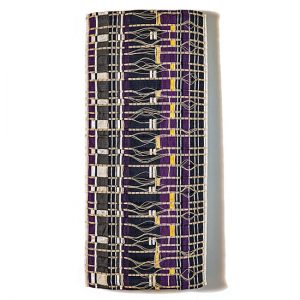
Paniers-liens III, Séphanie Jacques
carved wood (ash), white willow, hemp rope, red, wool, 21.25” to 43.25” x 15.5” x 17.75”,2011.
Paniers-liens II, Stéphanie Jacques
carved wood (ash), white willow, hemp, rope, red wool, 22” x 17.25” x 17.25”, 2011
Earlier this year, we compared Artsy‘s list of fiber art pioneers and ours (see also Craft in America’s Pioneering Women in Craft). In the years since contemporary fiber first gained international attention, a group of younger artists have continued to experiment. Numerous artists from a decade or two or three later are identified as continuing innovations in this field, including Rosemary Troeckel, Lesley Dill, and Ernesto Neto and more recently, Sophie Narrett and Orly Cogan.
Of the artists that work with browngrotta arts, we’d point to five who continue to redefine the practice. Stéphanie Jacques of Belgium, combines clay, wood, photography, knitting and basketmaking to create works that reveal what is unseen.
Federica Luzzi of Italy, uses fiber to illustrate natural phenomena. Her current series of elegant macramés were born of conversations with researchers at the National Institute of Nuclear Physics in Frascati, Italy about concepts of dark matter, antimatter, nuclear, subnuclear physics and the particle accelerator.

Transición, Eduardo Portillo & Mariá Eugenia Dávila, alpaca; metallic yarns and silver leaf; moriche palm fiber, silk, 56″ x 24.25”, 2018
Eduardo Portillo and Maria Dávila from Venezuela take an experimental approach to all aspects of their work — sourcing, technique and materials. The artists spent several years in China and India studying sericulture, or silk farming, and since then their research has taken them worldwide. In Venezuela they established the entire process of silk manufacture: growing mulberry trees on the slopes of the Andes, rearing silkworms, obtaining threads from other locally sourced fibers, coloring them all with natural dyes and designing and weaving innovative textiles. This works include woven “mosaics” from their Indigo series. More recently, the couple has been incorporating copper and bronze into their work, using textiles as inspiration for works that are cast in bronze. The couple was awarded with a Smithsonian Artist Research Fellowship in 2017. Sue Lawty from the UK, has used her prodigious weaving skills to weave lead, and for the last few years, has created assemblages comprised of literally thousands of tiny stones, a pixilated ‘cloth’ of sorts.

